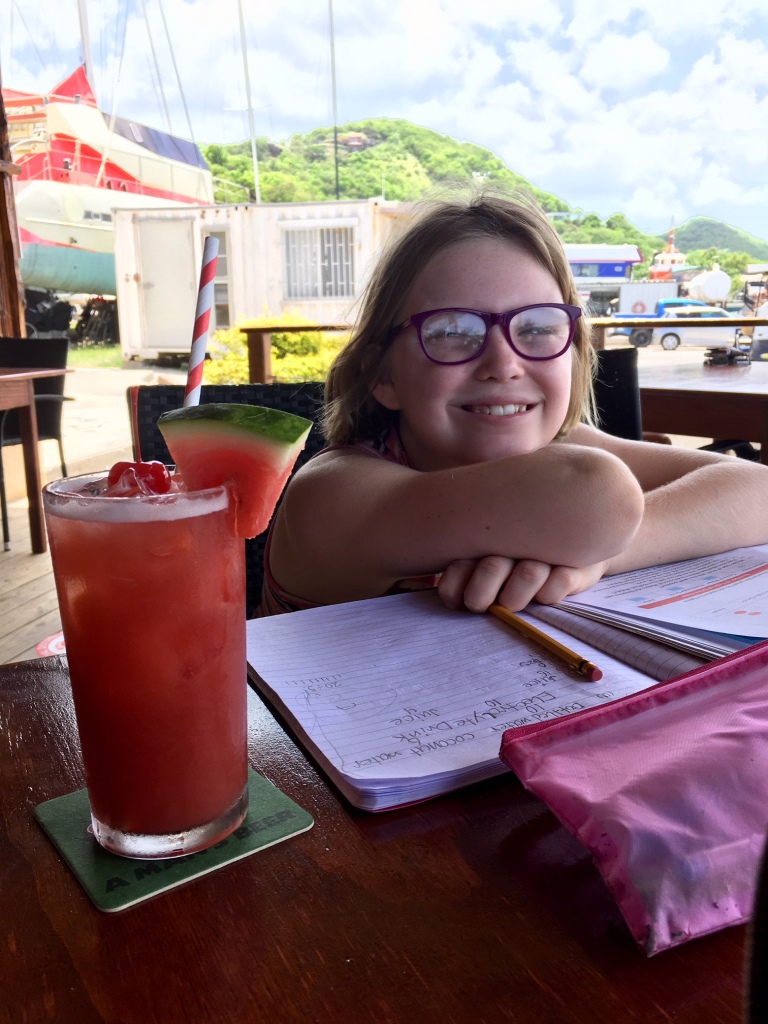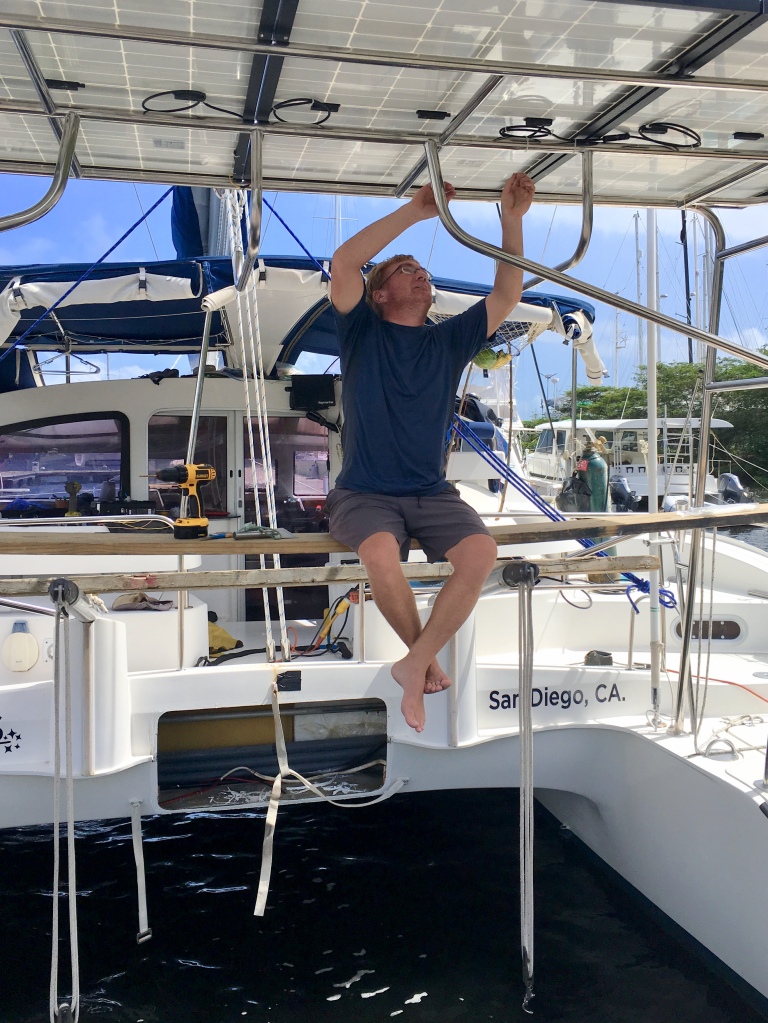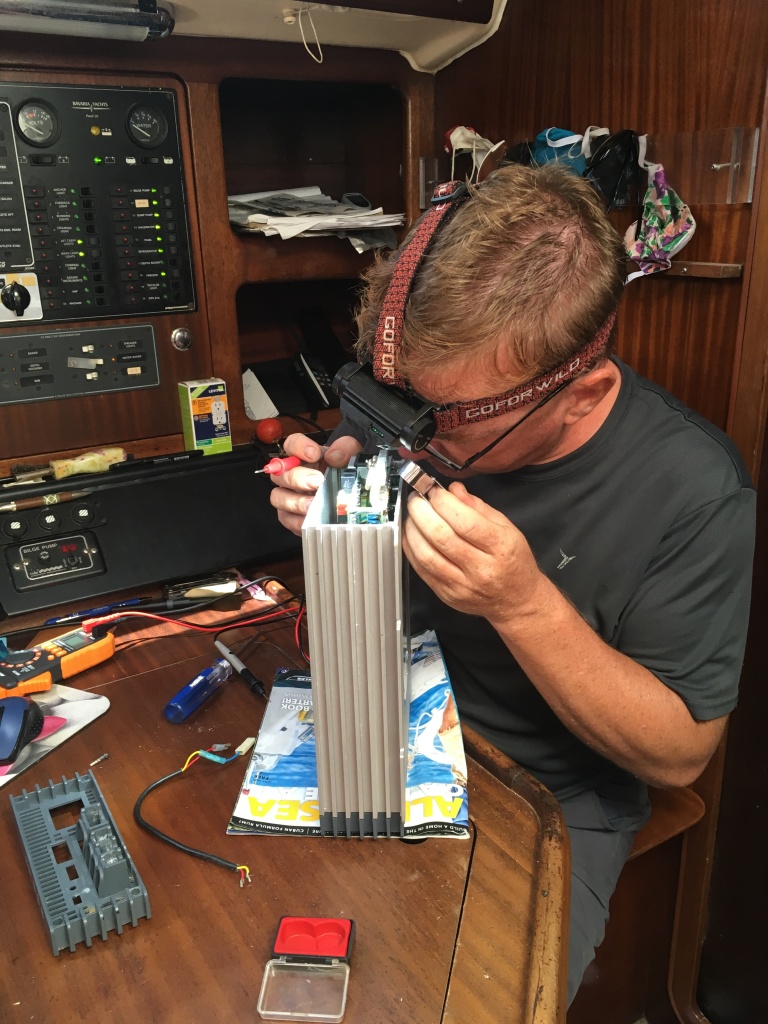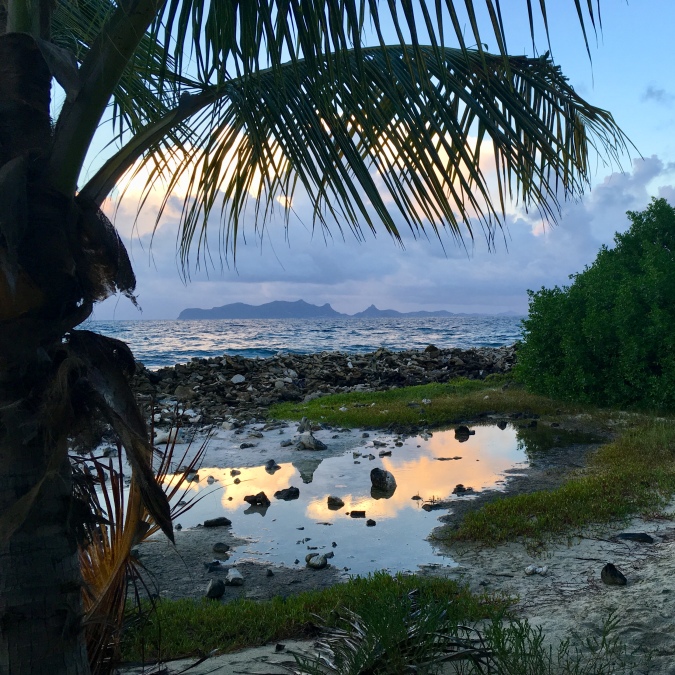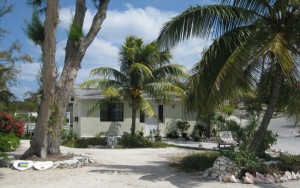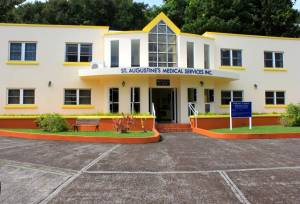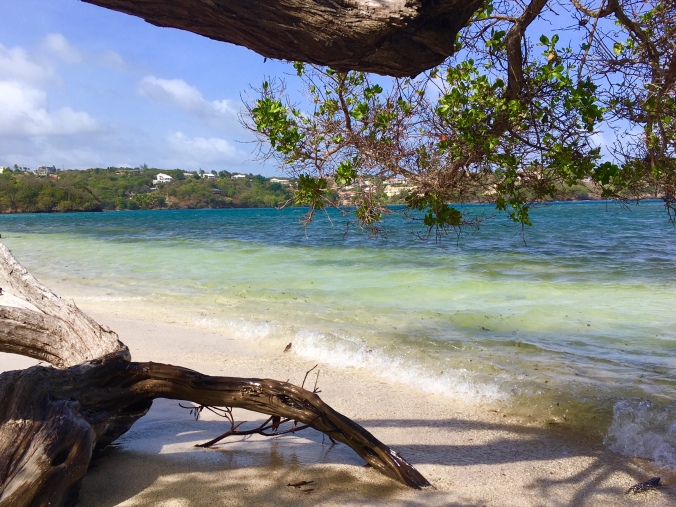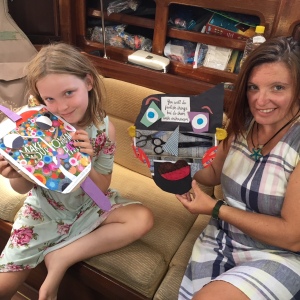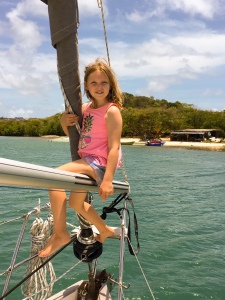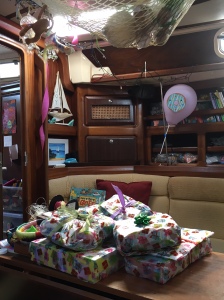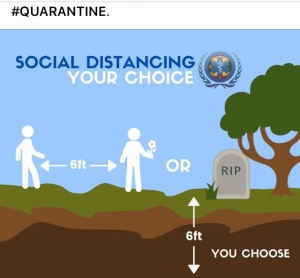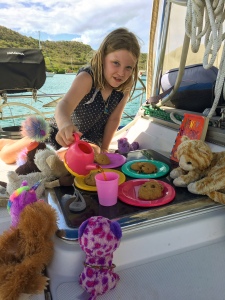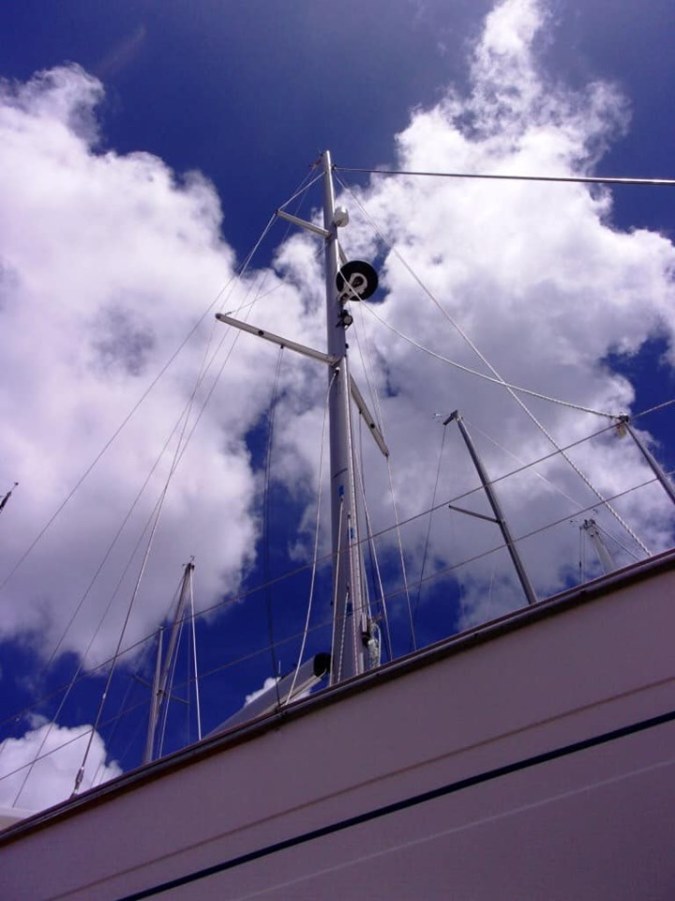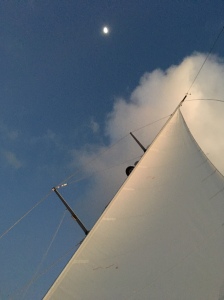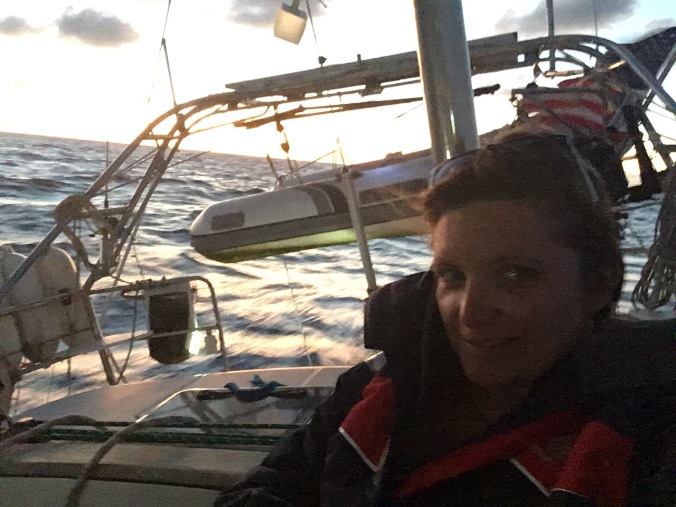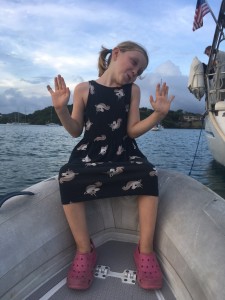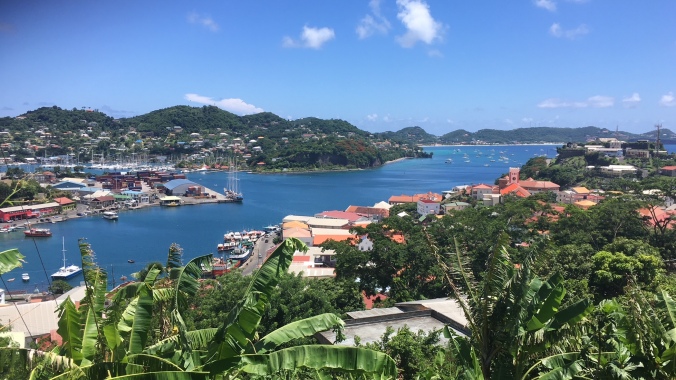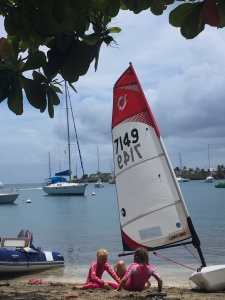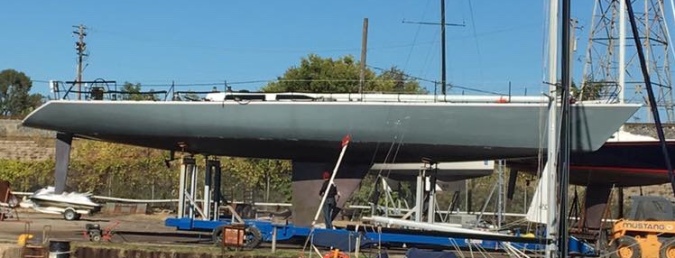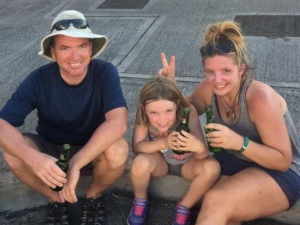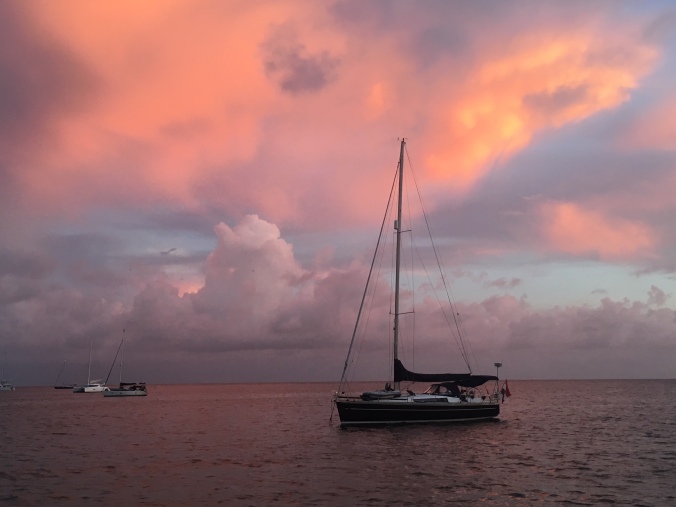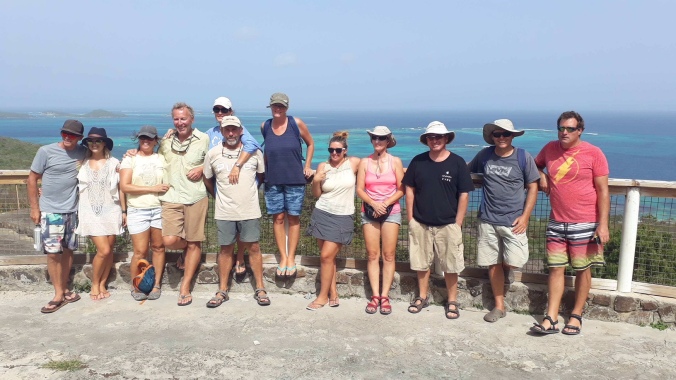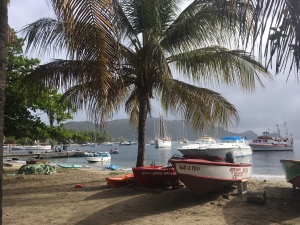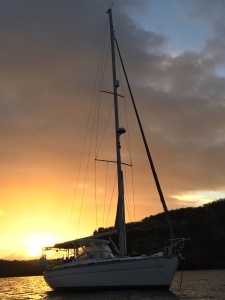
Sunset at Hog Island
As we float here at our anchorage in Hog Island, Grenada, I’m reminded of so many things to be grateful for. That when I look forward, I see a brand new rig majestically towering over us. That down below, Claire plays happily with a sound boat all around her – with boat parts replaced and fiberglass holes in the deck repaired. That I have complete faith in our home. That our home is still ours – better than ever.
Now that the claim has been officially closed, all bills have been paid and some time has passed, we feel comfortable putting down the specifics of what happened. More than $100k in damage was done by the failure of a section of tie rod going to our port side chainplate. The cause: work hardening. According to multiple surveyors, the large stainless steel rod likely had a manufacturing defect. Little by little it began breaking down, but from the inside out. There was no way that a visual inspection, either by us or by a professional rigger, would have seen it. Remember, we just had the boat completely re-rigged 11 months prior … more on that later.
That awful day back in March was the culmination of over a decade of weakening. The winds were comfortable, steady. The sea state was calm. It was just, time. The last bit gave and the whole thing went – from that chainplate, bursting up through the deck, and sending the whole rig over our starboard side.
The dismasting itself was over in 10 seconds, but the full-time job of the insurance claim, getting Clarity put back together, took months. We learned a lot in the process, things we want to share with you in case you find yourself in a similar situation, having to work through a huge claim and dealing with the fallout.
We had some very key things in our favor during this process. Our insurance underwriter, National Specialty Insurance; their third party claim investigator, Raphael & Associates; and our broker, Novamar, were amazing. They covered everything. So often, you hear negative stories about how insurance companies will do anything to get out of paying a claim, finding any loophole in your coverage to reject it. National Specialty went above and beyond for us.
Also, the contractors in Antigua who did the repairs did them well, and on time. Boat repairs without delays is basically an oxymoron, but not in our case. As we were hoping to get the boat out of the hurricane zone as quickly as possible, this was extremely fortunate for us.
Clarity is brand new from the chainplates up, a stronger boat than when we bought her almost four years ago. I don’t like the notion that everything happens for a reason. Sometimes, hardships are just hardships. But, you move forward, you learn from them, and you help others when you can.
IMPORTANT STEPS YOU CAN TAKE NOW
1. Service your chainplates as often as your rig.
When we saw a damaged shroud while hauled out in Puerto Rico, we never thought twice about doing a complete inspection and re-rig. Whatever was needed. Regardless of if we were to do it ourselves or had to hire it out, the rig isn’t something to cut corners on. We had everything inspected by two companies and told the rigger we chose to provide a quote to replace everything necessary, which we did.
What wasn’t done, nor we were advised to do, was to disassemble our tie rod and chainplate hardware and have it fully inspected. This doesn’t just mean ‘look at it’ carefully in place, but actually take it all apart. Anything threaded should be replaced, as the steel gets slightly weakened during fabrication. This includes bolts, tie rod connecting bars, etc. Oftentimes, and especially in our case, problems cannot be seen while installed. They will avail themselves during disassembly (break), during cleanup, or during a die-test, if chosen to be done.
Our tie-rod system looked perfect – shiny, with no pitting or rusting. After the dismasting, both surveyors shook their heads and said they hadn’t seen anything quite like it. We have no doubt that the hidden problem would have been found, had it all been disassembled. The riggers we consulted with during the dismasting repairs said they require all of their customers to do this, or sign a waiver saying they decline the inspection – thus limiting their liability. Our experience in Puerto Rico wasn’t so thorough, unfortunately.
The No. 1 thing we wish for you to take away from this post is, if you haven’t thoroughly inspected your chainplates and any associated tie rod system at some point recently, DO SO! Even if it requires removing interior finishing to gain access. Though we’ve had 20+ years of experience sailing big boats, this wasn’t on our radar during the re-rig. Be sure to have it on yours.
2. Review your insurance policy.
A few years ago, when we were shopping for an insurance policy for our boat, Aaron secured quotes from a handful of the major providers and we studied them, compared them, read through every little detail. We learned a lot from this article by Where the Coconuts Grow, which, while some things have changed since its writing in 2015, is still full of valuable info. Aaron pulled the trigger on a plan that was more robust than others, including something very important – consequential damage.
What that generally means is, when a claim is filed, aside from what is determined by a surveyor to be the actual cause of the damage, everything else that was damaged as a result of that cause is covered. For us, the port tie rod was the culprit. Everything else – the entire standing rigging, the fiberglass repairs, the woodwork, metalwork, the list goes on and on – everything else, was consequential damage. So even if it was determined somehow that we were at fault for the tie rod (which we were not), the rest would have been covered anyway.
We will never again sign on for a policy that does not include consequential damage. Unfortunately, such policies are becoming harder to come by and quite expensive. We understand that the policy we have with National Specialty isn’t even offered anymore, and we’ll have to sort through this come renewal time.
3. Track your repairs.
Any work that you have done on the boat, make sure that it is meticulously logged. Keep all receipts. Save all emails. If possible, document with photos that are time-stamped. If you are doing the work yourself, rather than hiring it out, keep a logbook of what and when.
This is not necessarily to point fingers in the event that something fails. This is to have solid proof that you are doing due diligence as an owner to make sure that you are addressing the normal wear and tear on your boat and fixing what is needed as it comes.
This was absolutely crucial to us in getting our claim reimbursed. As some of you may remember, we had our rigging fully inspected, and our standing rigging fully replaced, just a year before the dismasting. Thanks to Aaron’s methodical cataloging of all our important boat papers and pictures, we were able to prove immediately to our insurance company that we had taken care of Clarity to the best of our ability.
4. Make sure you are prepared ICOE.
In all of the sailing seminars we attended when hatching our dream, after all of the YouTube videos we watched on heavy weather handling and outfitting our boat, and during Aaron’s emergency training as part of his USCG Master’s license, we never thought we would actually find ourselves in such a serious situation out on the open ocean.
After the immediate shock of what happened, Aaron and I had to snap to the immediate next steps of what to do. With only the three of us on board, dragging the whole rig alongside our starboard side, sails billowing just underwater, Aaron made the correct call that we had to cut it all away so it didn’t damage the hull. Without more people on board, there was no way to safely save anything in the water. Wire cutters, bolt cutters, saws, our Dremel – we used it all. Not only were these tools critical, but they needed to be easily accessible. Fortunately, they were.
Make sure you have the right tools, and make sure you can get to them quickly when the clock is truly ticking.
Though we thankfully did not need to grab it, I had also fully packed a ditch bag. I will be honest, though, and say that the reason I did was because the event occurred on an overnight passage from St. Martin to Antigua, one where we would be spending a considerable part of it further offshore. I had gotten much more relaxed with packing a ditch bag on our smaller sails.
I stress again that when the tie rod failed, it was just, time. It could have easily happened on the four- or five-hour sail from St. Anne, Martinique, to Rodney Bay, St. Lucia, for instance, or hopping from one anchorage to the next. If the hull had been damaged, if the boat was taking on water rapidly, we may have needed to board the dinghy and abandon ship. Potentially no time to pack.
When Clarity was put back together again and we sailed her down to Grenada, you better believe that ditch bag was loaded and ready for every hop.
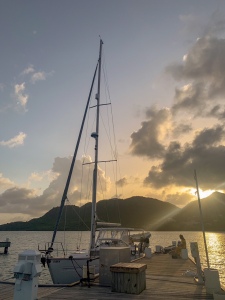
Clarity finally back in the water in Antigua, repairs completed.
LESSONS WE LEARNED IF YOU FIND YOURSELF STARING AT A BIG CLAIM
While we certainly weren’t looking to learn how to navigate the claim process with our insurance company, in hindsight, we see things we handled well and things we could have handled better. Here are a few observations, with the caveat that this is how things worked with our insurance company. Other companies may handle things differently.
1. Initially, stick to the facts.
When we limped in to Jolly Harbor in Antigua, aware that we had a huge hurdle ahead of us with insurance and not sure how to approach it, we got some extremely helpful advice from a friend and fellow cruiser. Don’t assume blame. Don’t assume that you need to make a case for why you are not at fault. When you make the initial call or email to your provider to start the claim, keep it brief: state what happened, state any important facts you feel are needed (for us, in our initial document, we stated that we had replaced our rigging a year prior), and leave the rest to how the process plays out.
2. Put your best foot forward.
Our insurance company quickly scheduled a surveyor to come to the boat in Antigua and make his assessment of the cause of the event. Even in our disheveled state, before the adjuster came, we did our best to clean up Clarity. We remedied the mess down below, the undone dishes and scattered belongings from our passage, and restored order. We put away the tools that littered the deck, obviously leaving all damage from the dismasting as it stood. Perhaps none of this mattered, or maybe it made a huge difference. Either way, knowing that the surveyor had our fate in his hands, we wanted him to step on the boat and have the immediate impression that a) this was our family home and b) we cared for it and maintained it as such.
After the initial phone call to our broker, we provided a concise ‘Owner Incident Report,’ including a description of what happened, procedures taken to mitigate further damage and maintain safety of persons aboard, coordinates and weather conditions, resultant damage, explanation of the recent re-rig with receipts, contact info, and photographs. We feel that the professional documentation provided by us all through the process was instrumental in our claim. Don’t assume your insurance will know something unless you tell them – concisely, as you’re most certainly not the only claim on their desk.
Finally, maintain a good relationship with your insurance investigator/adjuster. We would read and revise every email and document we sent to him, and Aaron would write down exactly what questions he had before every phone call. Our adjuster, James, was always patient with us and Aaron always expressed gratitude. Be kind. Imagine the grumpiness they deal with every day. If you’re one of the most pleasant people they deal with that day, it can only help with getting things processed.
3. Patience is a necessity.
Settle in for the long haul. Resign yourself to the fact that every step of the process is going to take time, and come to terms with it, even though there will be nothing you want more than to move things along. It took us two to three months to even learn that we would be covered. The claim was fully closed seven months after the dismasting. Though this felt like forever to us, we know that our insurance company actually worked very quickly. For many others who have gone through similar claims, it can take a year or more.
4. Get approval for emergency repairs while you wait.
Likely, there will be some repairs that cannot wait for a lengthy claim process. For us, we had a hole in our deck that needed to be immediately patched, unless we wanted an indoor monsoon every time it rained. We explained to our adjuster that we needed an emergency patch to prevent additional damage, and it was approved, with the idea that a full repair would be done further down the line.
5. Getting work estimates is your responsibility.
When we first started the claim process, it was unclear to us where the responsibility fell in actually lining up estimates for the repairs. Did our insurance company have preferred contractors in our area that they would contact? How would that work?
We learned quickly that we were responsible not only for finding contractors to quote each and every aspect of our repairs, and there were many, but also for getting competing quotes, so the insurance company could review them. As you can imagine, these things happen on island time – better saddle up to another healthy dose of that patience.
Aaron did the research to find the contractors on island, coordinated to get them out to the boat to assess the work, followed up with them to get their quotes in writing, and then compiled all required information to send over to insurance. This was all before we were told that our claim would be covered.
6. Prepare for a full-time job.
Getting the competing quotes to submit to insurance was just the beginning. We thought that the insurance company would be way more involved in the whole process of actually hiring contractors and getting the boat fixed, but they are really just the money men. Once they approve the cost of the contractors, you still have to hire them. Schedule them. Oversee them. And pay them. Your insurance company pays you, you pay them – at least in our case.
7. Hire a project manager.
We did not hire our own project manager/surveyor until three-fourths of the way through the repairs, and this was an oversight. We would highly recommend hiring someone independent, who’s acting on your behalf, serving as the liaison between you and the contractors, and checking and documenting the work. This would have been especially helpful in our case, since we were juggling more than four contractors for four separate aspects of the repairs.
In addition, not to name names, but we found one particular contractor in Antigua absolutely awful to deal with (something that did not become clear until after the contract was signed and the work was started). The work itself was excellent, but the experience with this contractor was traumatic, on top of an already terrible time for us. It would have saved a lot of added stress to have someone serve as the go-between. You can submit the cost of a project manager to your insurance company as part of the claim and see if they will cover it. Ours would not, so we paid out of pocket in the end, but it really is a necessity.
Also, note that no one will care as much about the project as you. So, even if you hire a PM, stay involved. Be on-site regularly, but don’t be a pest. Owners can make a mess of things by trying to be overly involved in every decision. Trust the talent you hire, but stay involved at every step and stay organized. The process will generate a ton of paperwork, so come up with a system. Aaron used Google Drive and scanned any hard copies so he could access any file at any time from any device in any place – which he did, seemingly seven days a week for seven months.
8. Keep the claim open.
Seriously. I know you’ll want closure. Keep it open. Once the claim is closed, it cannot be reopened, and that means that you cannot receive any additional funds from your insurance company without some hassle.
For us, there was the obvious damage from the dismasting, but over the course of the next few months, we inevitably found more. When it rained, we found new leaks. As our heightened emotions in the immediate aftermath of the event calmed down, we saw more clearly and found additional damage around the deck, which we were able to add into the claim.
I can’t stress enough that our insurance was wonderful to work with, and though it was a slow process, we never felt pushed to get things wrapped up prematurely. In speaking with others who have had big claims, they were rushed to get it closed.
9. Understand the money.
Both how you’ll receive it from insurance, and how contractors expect to be paid. Also, the timing. First, let’s talk timing.
Many contractors require a deposit on larger jobs before they will start working. Also, in our case, we needed to get the order in to the factory for our mast, and we had to pay half before it would even be put on the build schedule. Before work could even begin on Clarity, we had to pony up at least $25k. So that you are not floating this from your own funds, work with your insurance company to approve and make partial payments, with the remainder to be sorted when the work is completed. We worked out four separate claims / disbursements over the seven months.
Another part of the money is understanding how it’s going to be paid to you by insurance, and how you need to pay your contractors. If you have a loan on the boat, the bank may require that they receive the money first, which can cause major delays. If you have a loan, ask your bank to allow insurance to directly pay you to prevent schedule problems. If you’re out of your home country, plan time for international wire transfers.
The next element was paying the contractors. Again, these were large payments. Our insurance company and our bank are based in the States, but the work was done in Antigua. The charges were too high to carry on a credit card. In addition, for the biggest part of the repairs, we were in the States while the boat was in Antigua, so we weren’t on-site to pay cash. We were back to international wire transfers and there are fees associated with these. For the bills where wire transfers were the only option, we did submit to insurance to be reimbursed for the associated fees. It’s all part of the dance.
Then we have the final piece of the money puzzle – and it goes back to timing. With repairs in Antigua coming to a close at the end of August, we wanted to get the boat out of the hurricane zone as quickly as possible (actually, we did wind up dodging a hurricane right as we were looking to start our passage south). If we had waited to start initiating payments until the work was 100% completed, we would have been stuck another week or more, just on account of the time for the transfers to process, etc.
In addition, one contractor (shockingly, the same rigger I referenced before) put a “No Cash No Splash” hold on our boat, which meant that they wouldn’t put it in the water until the bill was paid. This is not unheard of when projects are this big, but it was an additional challenge for us, as we wanted to splash the boat as soon as possible so we could move back on board and get it ready for passage as the final repairs were sorted.
10. Prepare for unforeseen costs.
Our dismasting was covered 100% by our insurance company. It’s the reason we are still out here, living aboard – otherwise, the $100k+ price tag would have caused us to pull the plug. BUT, even when everything is covered, there’s more.
We had every intention of getting the boat down to Grenada well before hurricane season, but the dismasting happened just outside of Antigua, and we could not safely move the boat until it was fixed, which would be late August at the earliest. This meant that the boat was in the hurricane zone during hurricane season. We were grateful that our insurance company continued to cover us, but, we had to pay out of pocket for the additional coverage. Coverage in the box is considerably more expensive, like in the thousands more expensive. Awesome.
Some of the work was done on Clarity at the dock, so we were able to live aboard. However, for the critical couple of months including getting the mast and rig put back on, the boat had to be hauled, and the yard did not allow liveaboards on the hard. The boat is our only home, so we either had to find a place locally to stay for two months, or go back to the States to stay with family, which would still require international flights for all three of us. Though we asked for insurance to compensate us, they declined. Another out-of-pocket price tag in the thousands.
The final blow for us was the complete grenade the dismasting threw into our life plans. We had planned to enjoy Antigua in March and April and then quickly head south to Grenada by early May so that Aaron could establish his marine electrical business here. We would use that money for monthly expenses, put Claire in school for a semester, and to refill our cruising kitty for the next season.
Instead, the boat was in Antigua until late August. When we did make it down to Grenada by September, Aaron immediately went through the paces of establishing his business here, but it’s a process. Here we are in early February, still waiting for final approval from the Grenadian government on his permit. Write your plans in the sand at low tide, they say…
11. Extend help if you see others in the process, and extend grace if you’re in it yourself.
Right after the dismasting happened, we were in shock. We didn’t know which way was up, and we definitely couldn’t put two and two together to ask for help. Luckily, the cruising community is unlike any other, and we were surrounded by a huge support network that helped us in ways we wouldn’t have even thought to ask. That first night, one family cooked a huge pot of delicious food for us and dropped it off with a bottle of wine, no questions. They figured, in all the chaos, meals would be the last thing on our mind, but were still important, and they were so right. That was a godsend.
Other friends took Claire out for play dates at the beach and invited her over for sleepovers. Not only did this help create happy memories for Claire in a really challenging time, but it allowed Aaron and me time to sort through the mess, literally and emotionally, without having to try to keep it all together in front of her.
Still, other cruisers who had dealt with the claims process before offered to help us with ours, reading some of our initial correspondence with our insurance agent and helping us shift our frame of mind from absolute doom and gloom to trusting that we had made the right decisions all along, with our insurance plan, with our repairs, etc.
Finally, extend grace. When we dinghied to shore to check in to Antigua, we were zombies. I couldn’t put a sentence together. We ran into another cruiser at the dock: I think I said hello, but I may not have, and I’m 100% sure I came across as cold and rude. I didn’t realize until a few days later that it was a friend of ours, and I felt so terrible. If you come across someone and they seem off, try not to be too quick to judge. You never know what’s going on under the surface.
If you’re the ones trying to navigate the crisis, extend grace to each other (your spouse, your kids). And to yourself. Whatever event you may have experienced – a dismasting, a lightning strike, hitting a reef, etc. – is, at its core, a trauma. There will be fallout from that. PTSD. All three of us experienced it at different times, and often, when we least expected it.
We were lucky that for the most part, Aaron and I were not at low points at the same time. One of us was usually able to help the other out of it. But this is a time to extend grace, to come together as best you can, to be a team and try to make it through even stronger on the other side. This could have broken us – some days, we were pretty certain that it had. But in that vulnerability, we were able to find common ground and commit to seeing this through, however it played out.

